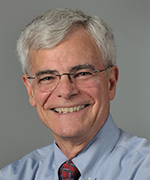From the Deputy Director for Intramural Research
Seek and Ye Shall Find: Collaborative Science at the NIH

This issue of the NIH Catalyst has a story on finding collaborators at the NIH. I would warrant that there is no established scientist at the NIH who has not benefitted from a collaborator who is also part of the intramural program. And a brief survey of intramural publications reveals the enormous extent of collaboration with both intramural and extramural scientific colleagues.
I myself feel very strongly about the importance of collaboration, not only because of my personal scientific interactions, but also because I have seen time and again difficult problems solved when appropriate collaborators are sought and found.
My own story begins with my long-term collaboration with Ira Pastan, co-chief of the National Cancer Institute’s (NCI’s) Laboratory of Molecular Biology, to study the molecular basis of drug resistance in cancer. We assembled a team of scientists to clone and characterize the energy-dependent ATP-binding cassette subfamily B member 1 (ABCB1) drug efflux pump, also known as P-glycoprotein, and this work led to a deeper understanding of drug pharmacodynamics and drug resistance in cancer. This effort is an example of how a team of scientists was assembled to solve a specific problem.
The cloning of the ABCB1 gene resulted from a collaboration with extramural researcher Igor Roninson, currently a professor at the College of Pharmacy at the University of South Carolina (Columbia, South Carolina). He had invented a technique for cloning amplified genes from cultured cells whereas we had cell lines in which multidrug-resistant genes were amplified. The rest, as they say, is history. (My lab is continuing to define molecular tools that detect resistance mechanisms in cancers and devise ways to circumvent or exploit this resistance for treatment of multidrug-resistant cancers.) ]
In my position as Deputy Director for Intramural Research, I talk to quite a few scientists and attend many seminars at the NIH. I have become something of a vector for ideas and techniques that may be helpful to advance the work of individual scientists. For example, I meet with all of the tenure-track investigators during their first year or two at the NIH. As we talk about their science, I suggest other scientists at NIH who might have a technique or a model system that could advance their science. Not infrequently, these interactions result in new collaborations. These meetings provide a relatively formal structure for suggesting collaborations.
Howard Gadlin, former NIH ombudsperson, and Michelle Bennett, director of NCI’s Center for Research Strategy, developed a practical and effective instruction manual for how to successfully create collaborative teams (“Collaboration Team Science Field Guide”).
Many of our interactions with our colleagues, however, are quite informal yet informative. There is a legendary observation, attributed to the Nobel Laureate Martin Rodbell, that the slow elevators in the Clinical Center led to many a lengthy discussion with colleagues from which great ideas for experiments were derived. So each of us, by attending seminars, the NIH Research Festival, and initiating conversations in the hallways, elevators, and on the pathways of NIH, can contribute to a climate of collaboration with profoundly positive effects on the science here.
My office is constantly in search of new and better ways to stimulate collaboration. Several years ago we initiated an Innovation Fund, generously supported by the NIH scientific directors, to encourage trans-NIH collaborative research. Although only about 20 percent of the researchers who submitted applications could be funded because of limited resources, many of those who could not be funded told me that the process of creating collaborative proposals led to new ideas for collaborative work that have since born fruit.
The Shared Resources Subcommittee of the Board of Scientific Directors enables the support of several core resources that have resulted in collaborations between individual scientists and core scientific staff. Our new trans-NIH collaborative research exchange website (CREx) has lists of most of the core facilities at the NIH and contact information to encourage trans-NIH collaborative activities.
In addition, there are other resources listed in a previous issue of the NIH Catalyst. And finally, the Office of Intramural Research sponsors the NIH Intramural Database, which provides text-searchable listings of all of the research that is going on in the intramural program. So if you need an expert collaborator—or even a cell line, reagent, or technique—just go to https://intramural.nih.gov and you can usually find whatever you need.
The major point, of course, is that science is dramatically accelerated when we work with each other and make use of the extensive resources available in the NIH intramural research program. I am sure that many of you have additional stories of how collaborations came about or other ideas about how to stimulate collaborations. Let me know.
This page was last updated on Wednesday, April 6, 2022
